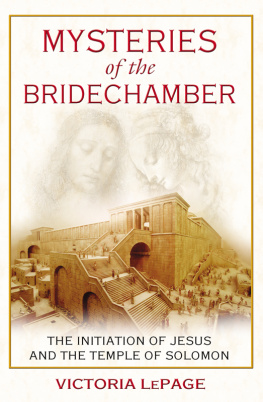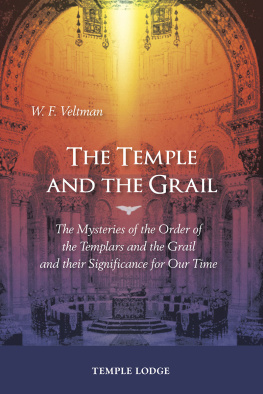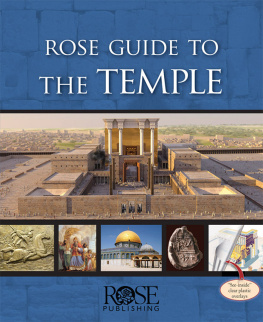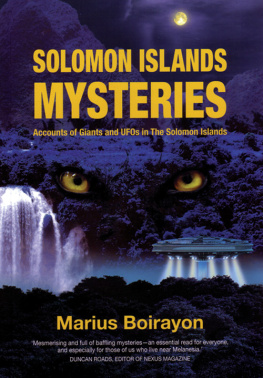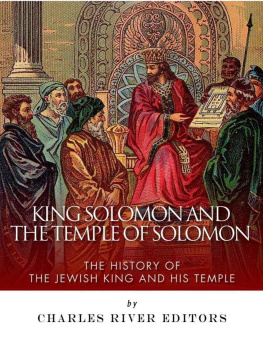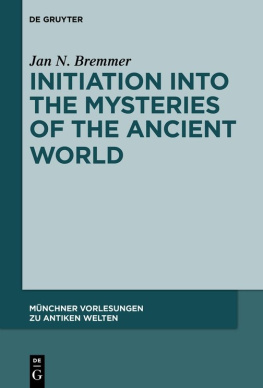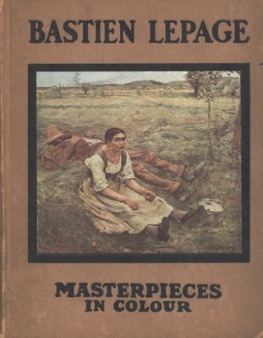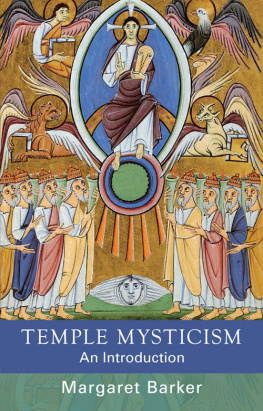Victoria LePage - Mysteries of the Bridechamber: The Initiation of Jesus and the Temple of Solomon
Here you can read online Victoria LePage - Mysteries of the Bridechamber: The Initiation of Jesus and the Temple of Solomon full text of the book (entire story) in english for free. Download pdf and epub, get meaning, cover and reviews about this ebook. year: 2007, publisher: Inner Traditions, genre: Science fiction / Religion. Description of the work, (preface) as well as reviews are available. Best literature library LitArk.com created for fans of good reading and offers a wide selection of genres:
Romance novel
Science fiction
Adventure
Detective
Science
History
Home and family
Prose
Art
Politics
Computer
Non-fiction
Religion
Business
Children
Humor
Choose a favorite category and find really read worthwhile books. Enjoy immersion in the world of imagination, feel the emotions of the characters or learn something new for yourself, make an fascinating discovery.
- Book:Mysteries of the Bridechamber: The Initiation of Jesus and the Temple of Solomon
- Author:
- Publisher:Inner Traditions
- Genre:
- Year:2007
- Rating:4 / 5
- Favourites:Add to favourites
- Your mark:
- 80
- 1
- 2
- 3
- 4
- 5
Mysteries of the Bridechamber: The Initiation of Jesus and the Temple of Solomon: summary, description and annotation
We offer to read an annotation, description, summary or preface (depends on what the author of the book "Mysteries of the Bridechamber: The Initiation of Jesus and the Temple of Solomon" wrote himself). If you haven't found the necessary information about the book — write in the comments, we will try to find it.
Victoria LePage: author's other books
Who wrote Mysteries of the Bridechamber: The Initiation of Jesus and the Temple of Solomon? Find out the surname, the name of the author of the book and a list of all author's works by series.
Mysteries of the Bridechamber: The Initiation of Jesus and the Temple of Solomon — read online for free the complete book (whole text) full work
Below is the text of the book, divided by pages. System saving the place of the last page read, allows you to conveniently read the book "Mysteries of the Bridechamber: The Initiation of Jesus and the Temple of Solomon" online for free, without having to search again every time where you left off. Put a bookmark, and you can go to the page where you finished reading at any time.
Font size:
Interval:
Bookmark:
MYSTERIES
of the
BRIDECHAMBER
THE INITIATION OF JESUS AND THE TEMPLE OF SOLOMON
VICTORIA LEPAGE

Inner Traditions Rochester, Vermont
ACKNOWLEDGMENTS
U ltimately, much of the inspiration for this book springs from my childhood memories of endless dinner table discussions, sometimes acrimonious, always intense, by my French-Jewish-Australian forebears on the subject of Religionreligion as occulted by the wondrous rising star of science. And eventually Theosophy added its voice to the Great Debate. My thought world has therefore been greatly influenced by the spirit of ardent inquiry that emanated from that displaced and somewhat rootless generation, and I owe it many thanks.
Nearer to hand, I owe a deep debt of gratitude to my late husband, Rayner, and to my son, Lamaan, for their unstinting support and encouragement in researching and writing this book; to Peter Martyn, without whose secretarial and computer wizardry the work might well have never found its way into print; to Tracy Cooper of Maverick Designs for her beautiful graphics; to the editorial staff of Inner Traditions/Bear & Co. for its guidance and expertise; and last but by no means least, to all my friends in the Southern Highlands for their enlightened contributions.
I would like to thank Quest Books, the imprint of the Theosophical Publishing House, for permission to reprint quotes from Jung and the Lost Gospels by Stephan A. Hoeller, who holds the rights to the work. I would also like to thank Arrow Books, an imprint of Random House, for permission to reprint excerpts from The Zelator by David Ovason. Indeed, my thanks are due to all those rich and diverse literary sources whose recent rediscoveries have opened up the ancient Wisdom of the Heart that brought Christianity into being, and in doing so have made this book possible.
CONTENTS
LIST OF ILLUSTRATIONS
PROLOGUE
SOLOMONS TEMPLE REVISITED
Most Jews remain to this day ignorant of their esoteric heritage, regarding it as a strange pursuit of the exceedingly Orthodox... Yet it cannot be denied that the Kabbalistic schools are the sole representatives of the Mystery religions that have continued uninterruptedly from the day of their foundation until the present.
JOSCELYN GODWIN
I n 70 CE Jerusalem fell to the Roman army, and the second Jerusalem temple, prime monument to a Yahwist version of monotheism, was burned down as King Solomons had been in 586 BCE. Of that first temple no archaeological trace remains. The search for it takes us back to a time before the Hebrew Bible was written and before rabbis wove the myths of Hebrew history, back into the deep past of the Hebrew people when historical fact and fantasy merge in the mists of yesteryear. Not until the fourth century BCE and the Jews return from their Babylonian exile are we on sure historical ground. Around that time a second temple was built in Jerusalem, and it was on its modest foundations that the Idumean Arab-Jew King Herod (d. 4 BCE) raised his stupendous edifice. His was believed to be the largest temple then known in the Roman world, certainly one of the most magnificent, and its fall was great.
The two teachers were foreigners, Hebrews from the outlandish northern provinces, where the Torah was tainted by old forbidden teachings. It was even whispered that the two might be prophets, though the prophetic orders were now outlawed and had long been exiled far to the north among the heathen.
Certainly the two foreigners were no rabble-rousers but men known to be of high repute, healers and miracle workers who brought in their wake supernatural signs such as had never before been seen. It was also said that they might be baptizing magi from the Delta city of Alexandria in Egypt, whereso rumor had it in informed circlesthe old Mystery teachings of Solomon were being revived in collaboration with Greek and Egyptian philosophers. Thought to be cousins, initiates of the Nazarean line, the two men were preaching not behind closed doors but directly to the people, on riverbanks and hillsides and in the synagogues, their tongues golden with a kind of heterodox wisdom that had not been heard openly in Judaea for as long as people could remember. The doctrines they voiced had long been outlawed by the Jerusalem authorities, creating in the populace a ferment of speculation and controversy.
It was incumbent on Jews of the day to attend the temple in the holy months, there to buy what livestock they could afford, a pigeon, a lamb, or a goat, and take it to a priest as a sin offering to be ritually slaughtered. Besides paying the temple tax, that was the sole extent of the religious obligations required by the temple. The practice of blood sacrifice for the atonement of sins was widely detested. The British historian A. N. Wilson tells us that the renowned first-century Greek Many Jews agreed with himespecially the liberalized, well-educated, and cosmopolitan Jews of the diaspora, those settled in great Hellenized cities like Alexandria.
The two northern teachers came to Judaea on the cusp of one of the greatest periods of religious reformation in Jewish history, bringing with them, among other things, an alternative to animal sacrifice. Instead, John the Baptizer, a famous spiritual leader, practiced free baptism in the Jordan River for the remission of sins; and during their separate missions both men brought conversions, exorcism of spirits, and initiation into forbidden esoteric teachings. It was said that the second preacher, Yeshua ben Joseph, even spoke cryptically for those with ears to hear about the Mystery teachings of the bridechamber, a topic long banned by the temple though still familiar to the populace. For contrary to modern assumptions, remnants of the pagan Mystery religions like the cult of Tammuz, with its hieros gamos or sacred marriage rites, still survived in Jerusalem in the first century, although long driven underground. Officially, the Great Goddess had been banished, as had her secretive royal rites, but among the people there still lingered memories of the pageantry and celebrations of the ancient Mystery cycle that had lain at the heart of temple worship.
Popular unrest increased when the execution of these holy men, one by beheading and one by crucifixion, was followed at a Pentecostal assembly by a wave of euphoric mass conversions to their cause. Thousands from every walk of life embraced the new revelation they had brought, including many of the younger priests of the temple who were dissatisfied with the venality and abuse of power that they witnessed there, and others from the sects of the Pharisees and the Essenes. Dangerous and incendiary rumors swept anew through the city, fueled by those who had undergone the Pentecostal spiritual transformation: the Messiah had come, or his reign was imminent; the laws of caste defilement were to be repealed, the sacrificial system made obsolete, the temple theocracy abolished, a new egalitarian dispensation begun, and the temple itself destroyed.
The second temple, magnificent though it was, had never won the same reverence from the Jews as had King Solomons legendary first temple. The present one, built at vast cost and dedicated to a Yahwist cult cast in a legal-ritualistic mold, had never been able to replace the earlier one in the Jewish heart and imagination. Like King Herod himself, the high priests and the senior clergy were despised as corrupt and autocratic quislings of the Roman power; and the temple, for all its grandeur, shared something of the spiritual impoverishment and general decadence that had befallen Judaism since the ascension to power of the Hasmonean priest-kings nearly two centuries before. As A. N. Wilson comments, [T]he temple, for all its marble and gold, was really a magnificently constructed abattoir designed to ease and ritualize relations between humanity and the Unseen. It could not compete with the aura of sanctity that surrounded the legend of the first temple, which had been destroyed, so it was said, by the Babylonian king Nebuchadnezzar in the sixth century BCE.
Next pageFont size:
Interval:
Bookmark:
Similar books «Mysteries of the Bridechamber: The Initiation of Jesus and the Temple of Solomon»
Look at similar books to Mysteries of the Bridechamber: The Initiation of Jesus and the Temple of Solomon. We have selected literature similar in name and meaning in the hope of providing readers with more options to find new, interesting, not yet read works.
Discussion, reviews of the book Mysteries of the Bridechamber: The Initiation of Jesus and the Temple of Solomon and just readers' own opinions. Leave your comments, write what you think about the work, its meaning or the main characters. Specify what exactly you liked and what you didn't like, and why you think so.

